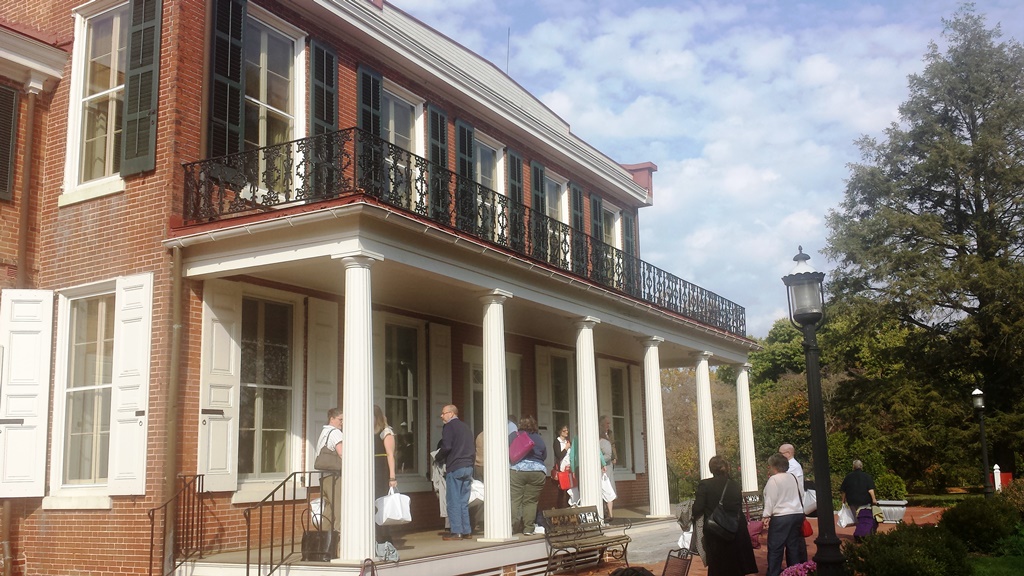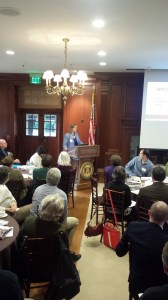By Cory Kegerise and Serena Bellew
From time to time, Bureau for Historic Preservation staffers are asked about how a particular process, form, or issue affecting historic resources in Pennsylvania is handled in different states. Fortunately, in the age of e-communication there are websites and listserves to provide answers to most of these questions. But no matter what field you’re in, nothing can replace some old-fashioned face-to-face interaction with peers and colleagues from other places to help bring a fresh perspective to your day-to-day work. And so, in that spirit, representatives from State Historic Preservation Offices from Maryland to New Hampshire gathered in New Castle, Delaware on October 28 & 29 for two days of information exchange and networking with each other, the National Park Service, and the Advisory Council on Historic Preservation.

Buena Vista State Conference Center, New Castle, Delaware.
The Northeast SHPO Regional Meeting was organized by the National Conference of State Historic Preservation Officers (NCSHPO) with support from the National Park Service. The Delaware Division of Historical and Cultural Affairs graciously hosted the group of 90+ people at the Buena Vista State Conference Center just south of Wilmington. The centerpiece of the Buena Vista complex is the 1847 Greek Revival mansion that was sold to the First State by former Governor C. Douglass Buck in 1965 for $1. Over the course of two days the group participated in small and large group discussions and roundtables, enjoyed walking tours of Wilmington and New Castle, and spent time catching up with old colleagues and developing new partnerships across state lines. Pennsylvania sent 12 BHP staff to the meeting, including representatives from the National Register, Community Preservation, Environmental Review, and GIS sections (and our Deputy State Historic Preservation Officer, too).
The first day started with updates from NCSHPO and NPS, including remarks from Dr. Stephanie Toothman, Associate Director for Cultural Resource Stewardship, Partnerships, and Science. While there’s a never-ending stream of policy and project-specific issues affecting historic preservation in the U.S., Dr. Toothman highlighted a number of points that are particularly relevant to SHPOs and the programs we administer. Among the hot topics was funding for the Historic Preservation Fund (HPF), which has never reached its Congressionally-authorized level and is due for reauthorization in 2015. The HPF is the major source of funding for SHPOs and directly impacts the staffing and activity levels for programs like the National Register of Historic Places and Historic Preservation Tax Credits. It is also the source of funding for the Certified Local Government Program, which requires SHPOs to distribute 10% of HPF funds each year to CLGs as grants. While Congress has level-funded the HPF for the past few years, there is a push to increase the funding level to the legislatively-authorized level of $150 million each year.

Serena Bellew updated the group on some recent preservation successes and challenges in Pennsylvania.
Each state also shared recent preservation successes and challenges and it was striking t hear how similar and different Pennsylvania is to its neighbors. Pennsylvania highlighted our successful Hurricane Sandy Recovery and Planning Program and the record-breaking attendance at FORUM 2014 in Philadelphia this past July as well as the Bureau’s ongoing efforts to improve coordination with our State and Federal partner agencies. The real oohs-and-ahhs of the day came when New York and Delaware gave the group demonstrations of their soon to be unveiled GIS and data management websites. New York is developing a new web-based database and mapping system that integrates information about specific historic and archaeological resources with survey, project review and tax credit submission systems. Pennsylvania (like many other SHPOs) has long had its eye on a similar system, so it was encouraging to hear that one of our peers had decided to bite the bullet and tackle the problem. Here’s hoping that after the kinks are worked out we can “borrow” the best of what works for the Keystone State! Delaware is preparing to roll out a new GIS-based system that provides maps and documents for historic and archaeological properties much like CRGIS, but with some exciting public history tools that let users build their own maps and collections of historic places. The Delaware SHPO hopes these custom maps encourage community organizations to use SHPO information to develop walking tours and interpretive programs and entice tourists to visit some of the underappreciated places in the state.
One of the pressing issues for many Northeastern states is climate change, disaster preparedness, and resiliency planning. A Tuesday afternoon panel that included NPS and SHPO representatives from New Jersey, Maryland, and Delaware talked about some of the national, state, and local level initiatives underway to ensure that cultural resources receive adequate attention in these efforts. NPS is preparing guidance on various aspects of these issues as they relate to historic buildings, while SHPOs are continuing to test and implement new strategies at the state and local levels. Perhaps most relevant to what’s happening (or about to happen) in Pennsylvania is Maryland’s work with the City of Annapolis on that community’s Hazard Mitigation Plan. As part of PHMC’s Hurricane Sandy funding, BHP will be working with numerous counties throughout the Commonwealth to integrate cultural resources and historic preservation principles into Hazard Mitigation Plans. In a state where flooding is an increasingly common occurrence, these plans may help to ensure the survival of some of the state’s historic communities. Learning from Maryland’s experience will only strengthen those efforts.
The last of the big group gatherings was on Wednesday when the Advisory Council on Historic Preservation shared some updates and fielded questions about Section 106 related issues in the states. That conversation was dominated by issues related to the U.S. Postal Service’s plans to close and dispose of post offices across the country in communities of all sizes. Given that post offices are often located in downtowns and serve as iconic civic spaces, the passage of these properties from public to private spaces can have significant effects on a community. Earlier this year, ACHP submitted a report to Congress (at Congress’ request) detailing the issues surrounding the closure of historic post offices and USPS’s compliance with Section 106. The findings weren’t exactly cheerful, but ACHP encouraged SHPOs and community leaders to keep them apprised of specific projects and to educate their Congressional representatives about the impacts of these decisions.

Bureau for Historic Preservation staff members pose for one last picture on the porch at Buena Vista.
In addition to the large group sessions, there were small group breakouts on each day covering topics ranging from archaeology to technology to CLGs to diversity in the National Register. The PHMC delegation divvied ourselves up to be sure that we had all the bases covered. When the group reconvened one last night before departing for our respective home states, we shared the highlights of each of these discussions with our colleagues. It was encouraging to hear that the Keystone State remains an innovator and leader in many ways and that our neighbors and partners have much to offer us in terms of advice and support. But most of all, it was great to be reminded that all of us working on historic preservation, community development, and related issues at all levels have counterparts in other places that are willing to share their experiences.
Comment Policy
PHMC welcomes and encourages topic-related comments on this blog. PHMC reserves the right to remove comments that in PHMC’s discretion do not follow participation guidelines.
Commenters and Comments shall be related to the blog post topic and respectful of others who use this site.
Commenters and Comments shall not: use language that is offensive, inflammatory or provocative (this includes, but is not limited to, using profanity, obscene, or vulgar comments); disparage other commenters or people; condone illegal activity; identify the location of known or suspected archeological sites; post personal information in comments such as addresses, phone numbers, e-mail addresses or other contact details, which may relate to you or other individuals; impersonate or falsely claim to represent a person or an organization; make any commercial endorsement or promotion of any product, service or publication.
If you would like to comment on other topics not related to this blog post but related to PHMC, please fill out the PHMC Contact Us Form.
Leave a Reply